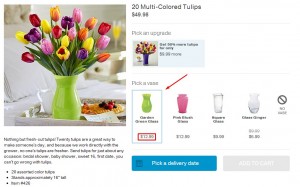In our first Interesting Infographic of 2015, HelpScout has given us some interesting insight into how to convert customers using psychology. Some of the examples are from a traditional B2C environment but I can see how we can apply it to our B2B lead generation strategies and tactics. Below are the 10 ways:
1. Help customers break through “action paralysis” by setting miminums
Research by Prof. Robert Cialdini shows adding a minimum to a request increased donations for the American Cancer Society by 78%. Remind your customers about how easy it is to get started to help them break through action paralysis.
For example if you offer a software product, perhaps you are offering a free trial or reach out for a conversation.
2. Embrace the power of labels
Researchers found people who they randomly labeled as “politically active” were 15 percent more likely to vote. Despite the fact that they were randomly chosen, the label ended up affecting their actions. HelpScout suggests that if we label our customers as part of a superior group then their actions will reflect those characteristics.
What labels can you use for your prospects to make them feel significant and special?
3. Understand the three types of buyers
Neuroeconomic experts have labeled human spending patters as a process of “spending ’til it hurts.” According to the research, there are three types of buyers: Tightwads, Average buyers, and Spendthrifts.
For example, if you are dealing with Tightwards, focus on bundling products or services and re-framing the product value.
What type of buyers do you normally deal with and how do you respond to them?
4. Highlight strengths by admitting shortcomings
According to data from social psychologist Fiona Lee, customers were more trustworthy of companies who admitted to “strategic failings” over those who blamed external sources for company problems (even if they were true). She concluded that buyers are okay with companies admitting to faults from time to time, as they show the company is actively looking to fix the problem.
It is very difficult to admit to our clients and customers, let alone the public, any of our failings. What type of failings do you think your company can share which would make your prospects look more favorably on you in accordance with this research?
5. Use urgency the smart way
Urgency and scarcity are known to drive up sales, but according to research from Howard Leventhal, people are prone to block out urgent messages if they aren’t given information on how to follow-up.
This research is interesting – how can we provide follow up information to our prospects and clients when we are using urgency and scarcity in the sales process?
6. Make their brain light up “instantly”
Several Magnetic Resonance Imaging (MRI) studies have shown that our frontal cortex is highly active when we think about waiting for something (that’s a no-no for more sales). To better appeal to customers, remind them that your product or service can solve their pain points fast.
In my view, this is something we can all follow and implement. We can do a better job of showing our prospects that our solution or product address their immediate pain points right away to encourage them to take that important first step.
7. Make an enemy
According to some research from social psychologist Henri Tajifel, people can be dived (and more loyal to their in-group) from the menial of distinctions. Companies like Apple leverage this through tactics like their Mac v. PC commercials. Making enemies is less about being harsh to people or competitors and more about labeling your customers. For example, you may say this is “only for athletes.”
8. Stand for something
Of customers who have a strong relationship with a single brand, over 64 percent said it was because they had shared values with the company in question. A great example is Tom’s Shoes, a company that donates a pair of shoes to those in need for every pair of shoes sold.
Do you share similar values with your prospects and customers? If not or you do not know, how can you better communicate this to them?
9. Devil’s advocate
Research shows that when groups of people have their ideas questioned by a “devil’s advocate,” they actually increase their confidence in their original stance. Your business can utilize this information by playing the devil’s advocate yourself, increasing the confidence of already interested customers who are the one’s most likely to buy your products. Address their concerns and dismiss them with well researched information and examples.
10. Keep ‘em on their toes
While customers value consistency, they also like surprises. In a classic study by psychologist Norbert Schwarz, he found that as little as 10 cents was enough to change the outlook of participants who found the money by surprise.
When and how did you surprise your prospects or customers?
(318)








